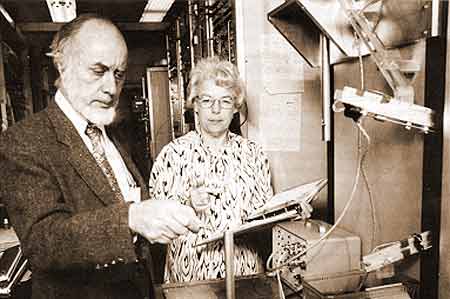
FRANK ASARO AND HELEN MICHEL AT WORK IN THEIR LABORATORY
In 1967 Isadore Perlman, who was then the head of Lawrence Berkeley
Laboratory’s (LBL) Nuclear Science Division, asked Frank Asaro and Helen
Michel to help set up a neutron activation analysis (NAA) system which
could be used to "fingerprint" ancient pottery shards. The idea
was to show what could be done in applying techniques of nuclear
spectroscopy to chemical analysis with the then-new germanium detectors.
Twelve years later, Asaro and Michel are still in the NAA business,
looking at the chemical composition of materials brought to them by
scholars and scientists.
Two years ago, they analyzed the elemental abundances in Sir Francis
Drake’s famed "Plate of Brass," showing that its composition
corresponded to brass made in the nineteenth and twentieth centuries, not
to brass made in the sixteenth century. By identifying the elements in
pottery shards and in obsidian tools, Asaro and Michel helped
archaeologists trace the ancient trade routes used by the Incas.
They have studied the chemical composition of the basalt flows in the
Columbia River basin as part of the search for safe repositories for
radioactive nuclear wastes. They have also analyzed the evaporates from
hot springs for information about the origin and behavior of geothermal
waters.
Now they are turning their attention to oil-shale deposits and to the
sea, analyzing core samples taken from the sea floor for LBL’s ocean
thermal energy group.
Along the way, they have brought NAA techniques to new levels of
precision and accuracy, and they have developed statistical procedures
which allow NAA users around the world to test and exchange information.
The NAA technique begins by taking a small sample of the material to be
analyzed, powdering it, and pressing it into pill form. The samples are
then bombarded with neutrons at UC Berkeley’s small reactor. Included
with the samples of unknown composition are known samples, called
standards, against which the unknowns can be checked and calibrated. All
the samples receive two irradiations: the first bombardment is a short,
low-flux irradiation for the major elements, followed by longer,
higher-flux irradiations for elements in trace amounts.
The neutron bombardment transforms certain isotopes of the elements
into radioactive species which then emit gamma rays. Each element has its
own particular gamma-ray fingerprint. A germanium detector counts the
emissions, sorts them out according to their energies, and then converts
them into electrical impulses which are amplified, stored according to
pulse height in a memory system, and finally recorded on magnetic tape.
After Walter Alvarez obtained material from the sedimentary deposits
near Gubbio, Michel and Asaro measured samples from the clay layer and
from the Cretaceous and Tertiary deposits on either side. To enhance the
sensitivity for iridium detection, measurements were made also on the
insoluble residues which remained after the limestone had been dissolved
in dilute nitric acid.
In order to test the expected worldwide nature of the iridium anomaly,
Danish limestone and clay sampled near the Cretaceous-Tertiary boundary
next were studied by the LBL-UC Berkeley team. The anomaly was even larger
than at Gubbio. Although this definitely suggests a worldwide effect, it
is not absolutely certain, as the sedimentation chemistry is not yet well
enough understood.
— By Phila W. Rogers
Additional Information:
|


